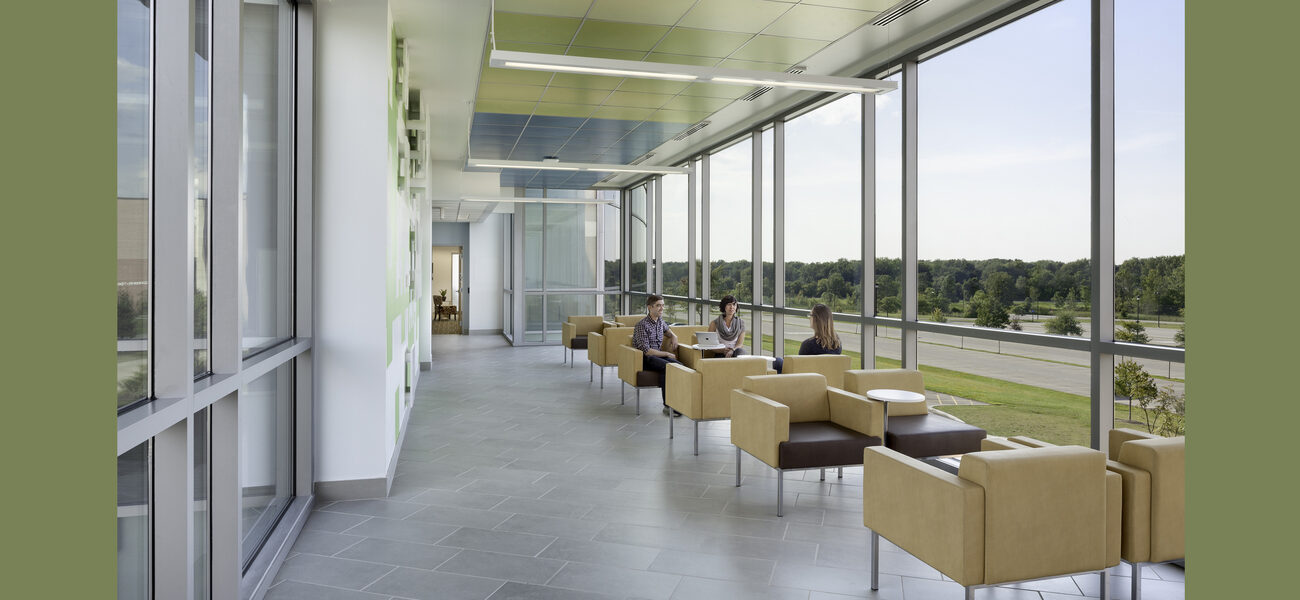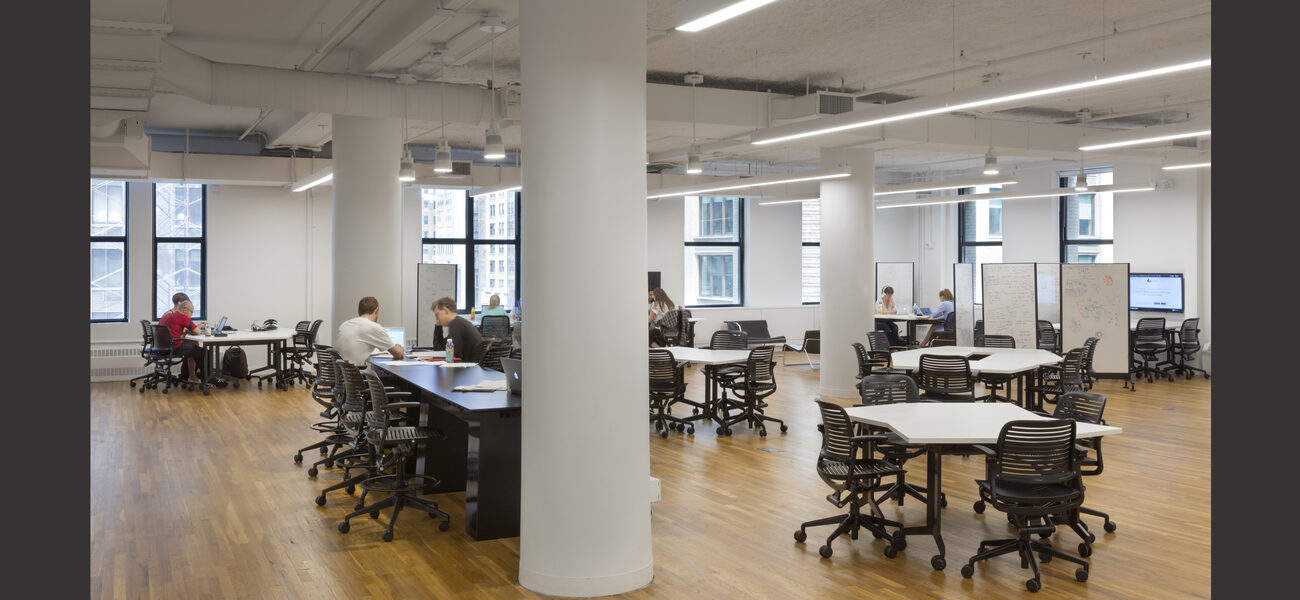As the landscape for academic institutions grows more competitive, determining how human factors impact the design of STEM facilities is becoming a significant consideration when it comes to attracting students and research faculty. As a result, team members at Francis Cauffman Architects are developing a set of metrics to identify and assess the value of design features that influence occupant experience in academic STEM spaces with the goal of creating an index that can be used to inform future renovation and new construction projects. Human factor points are allocated to spaces and design features that have a demonstrated positive impact on student enrollment, result in high levels of user satisfaction, and accommodate the teaching and research goals of the facility. In a post-COVID world, this additional evaluation tool may be more important than ever.
“COVID-19 has had a tremendous impact on the way those involved in academic STEM go about their business,” says Jay Hallinan, senior lab planner with Francis Cauffman Architects. “We are happy to see that the work we did developing this metric before COVID is still valid. Perhaps it is even more relevant now, as the global pandemic has hastened the existential crises many institutions of higher learning will be facing over the next decade. Getting the most competitive value out of capitol project investments is critical.”
In developing their internal rating system, the team referenced a report on the 30 best modern college renovations published in 2018 by Best Value Schools, which uses publicly available data to create independent assessments of US colleges and universities that provide an objective resource for potential students and parents trying to decide what school to attend. Almost half of the projects on the list (14 out of 30) were STEM renovations or STEM facilities, including the number one and two spots, and seven of the top 10.
“We are trying to boil all of this data down to the human design factors that translate into what it means to have a successful STEM project,” says Hallinan. “We looked at the positive aspects that were cited repeatedly in the report including things like: Does it foster a sense of collaboration? Does it allow for multidisciplinary or interdisciplinary work? Does it accommodate innovative teaching and learning? Does it foster a sense of connectedness? Does it facilitate student access to faculty and specialized equipment? And does it have a high perceived level of prestige?”
Applying these criteria, the team identified five categories for a proposed human factor rating system: connectivity, multiplicity, accessibility, choice, and identity.
“Anything we can do to analyze or predict the success of the projects we undertake or calculate the return value for investment is a worthwhile exercise. That is what we are trying to do,” says Hallinan.
“We design spaces to educate people, but how does the human factor relate to that?” adds Wan Leung, science and technology principal at Francis Cauffman Architects. “How do people react physically, psychologically, and emotionally to a built environment? That is what we consider human factors to be.”
Human Design Factors
Connectivity is defined as spaces that support the creation of bridges for students and faculty to connect with each other as well as with outside corporate, industrial, and government partnerships.
“Connectivity has changed the way we work, specifically with STEM professions,” says Leung. “Whether you are an engineer, a scientist, an analyst, or an economist, the paradigm in this century has shifted from a traditional solo learning model to a connected world. It is breaking down the barriers to information sharing and learning.”
Another significant theme for STEM disciplines is multiplicity. This means providing multiple settings that foster different educational experiences and creating spaces that can be easily adapted to different functions. It also means supporting multi-stage teaching approaches with classrooms and laboratory settings that flow from electronically based formats to hands-on workshop formats or lab work.
“Howard Gardner’s ground-breaking research on multiple intelligence theory in the early ’90s had a huge impact on the practice of education over the past 30 years,” says Hallinan. “What he did with that model was differentiate between eight different modes of human intelligence rather than trying to lump all of them into one general ability. A recent study conducted by the University of Chicago tried to map the modalities that different students respond to. The main conclusion of that study, and others like it, is that all students benefit from a variety of educational delivery methods. The idea is that no one specific setting or teaching methodology is going to give you the optimal outcome. You need variety to achieve the best results.”
The Best Value Schools rankings also showed that many of the institutions with top-rated remodels invested in increased student access to faculty who are experts in their field, access to specialty tools, and access to specialized facilities where students can conduct their work.
“It is really what students are looking for these days,” says Leung. “Access to a nurturing environment, other students, and people working in the broader field that they are pursuing.”
Research is also showing that choice is a significant human factor. This means giving educators and students choices in the types of spaces they use and accommodating the different ways educators teach.
“Choice is about freedom,” says Hallinan. “So we’re talking about providing spaces that are well designed for thinking, whether it is for individuals or small groups. Spaces that accommodate the practicing of a skill, whether that’s a simulation environment or a maker space. And spaces that allow for the communication and sharing of knowledge, whether that is between a faculty member and a class, an instructor and an individual student, or student to student. Again, it’s about accommodating the different ways that students learn. It is really becoming a prerequisite for contemporary STEM facilities. The challenge is, how do you find the right menu of those types of spaces when you’re in the pre-planning, programming, and design process?”
Institutional identity is one of the most nebulous human factors from a design standpoint, but it is a significant element when it comes to the perception of educational value.
“It is important for universities to develop a brand identity and associate that identity with their STEM facilities, so students can carry that identity into the future,” says Leung. “This matters for academic STEM environments, because corporations and government agencies associate value with where you received your education.”
Scoring Space Types
When it comes to applying the point-based rating scale to different academic environments, certain space types stand out more than others for meeting human factor needs. At the top of this list are student spaces, maker spaces, active learning spaces, and practical simulation spaces.
“Informal student spaces outside of the classroom or laboratory have really become prominent in the last couple of decades,” says Hallinan. “What we are seeing now is that colleges and universities are dedicating an average of between 7 to 15 percent of the net assignable square footage to informal spaces that are extensions of the learning environment. This indicates that they add value when it comes to connecting people. It is also easy to create multiple types of settings on various scales with this type of space, whether it is individual spaces or large open spaces that accommodate large functions. They offer a lot of freedom for people to come plug in and have a cup of coffee, connect with members of the community, and spend a good chunk of their day between classes. That sense of freedom and choice adds a lot of value. Because these spaces also tend to be at the entrance to a STEM facility or the front door of a campus, they offer institutions the opportunity to build their brand image and foster that sense of connectedness. For those reasons, student spaces score very highly in terms of human factor values.”
Team-based active learning spaces, simulation spaces, and maker spaces also score highly because they provide different choices in learning modalities, access to specialized equipment and people, broad connectivity, and an elevated sense of identity.
“Team-based learning environments are probably the most important space type of the last 40 years,” says Hallinan. “And I don’t think there is any campus space right now that captures the imagination more than the idea of maker spaces. So they score a five out of five on the human factor scale.”
Applying a Human Value Index
The question is, how can designers and facility owners develop a practical way to measure the human factor of different spaces in a way that informs decision-making and validates return on investment for STEM renovation and construction projects? One idea is to approach the subject in much the same way facility owners use a facility condition index to determine whether a building should be renovated based on the relative costs of needed maintenance and modernization upgrades versus the cost of replacement.
“We like to utilize what we call a facility value index (FVI),” says Leung. “It essentially combines a facility condition index with a functional index that measures how well a facility performs its intended purpose. Then we add the human factor index to that to come up with a facility value index. When we focus on the human factor and apply our metrics to it, we know that if we were to improve an existing facility to current standards, we would typically see investments of 8 to 16 percent of cost. So, when we combine all of the other indexes with that, we come up with an FVI index. If it reaches an index of 0.65 or 0.7, that suggests replacement of the facility.”
Applying this combined index approach can help owners determine what space types warrant investment and how to prioritize limited funding to attract more students and improve outcomes.
“When we’re looking at the question of renovating or replacing an existing facility, we actually go into each of those spaces and look at how well they achieve these human factors. If a facility is 30 years old, it is probably not going to satisfy much of that. Then we rate those spaces on a scale of one to five and apply it to the index. I think this is an important index to consider and, if it takes root, it could be really helpful for informing the decision-making process at a lot of institutions.”
By Johnathon Allen

